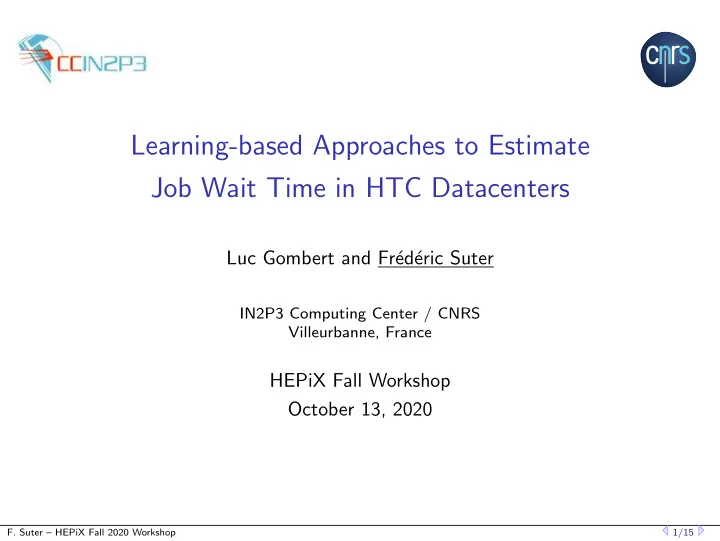

Learning-based Approaches to Estimate Job Wait Time in HTC Datacenters Luc Gombert and Fr´ ed´ eric Suter IN2P3 Computing Center / CNRS Villeurbanne, France HEPiX Fall Workshop October 13, 2020 F. Suter – HEPiX Fall 2020 Workshop 1/15
Previously in HEPiX series . . . ◮ A first study of the workload processed at CC-IN2P3 ◮ Focus on fairness for Local users ◮ Simulation of queue reconfiguration F. Suter – HEPiX Fall 2020 Workshop 2/15
Acknowledgment ◮ Original motivation for this work came from a talk by Wataru Takase (KEK) at the FJPPL — Japan-France workshop on computing technologies F. Suter – HEPiX Fall 2020 Workshop 3/15
Motivations and Objectives ◮ Fair-share scheduling ⇒ no estimation of job start time returned to the user! ◮ Distribution of Local job wait time ◮ Over 23 weeks from June 25, 2018 to December 2, 2018 ◮ 5,748,922 jobs on 35,000 cores 0.25 26.9 % 29.3 % 33.6 % 10.2 % 0.20 Density 0.15 0.10 0.05 0.00 10s 1m 5mn 30mn 3h 9h 1d 3d 1w 1mo Job wait time F. Suter – HEPiX Fall 2020 Workshop 4/15
Motivations and Objectives ◮ Fair-share scheduling ⇒ no estimation of job start time returned to the user! ◮ Distribution of Local job wait time ◮ Over 23 weeks from June 25, 2018 to December 2, 2018 ◮ 5,748,922 jobs on 35,000 cores 0.25 26.9 % 29.3 % 33.6 % 10.2 % 0.20 Density 0.15 0.10 0.05 0.00 10s 1m 5mn 30mn 3h 9h 1d 3d 1w 1mo Job wait time 1. Can we explain why a job waits more than another? 2. Can we train some Machine Learning algorithms? 3. Can we get a good estimation of job wait time in the orange and red zones? F. Suter – HEPiX Fall 2020 Workshop 4/15
Outline Introduction Some Intuitive Causes of Job Wait Time Who Submits the Job? What is the Job Requesting? When and Where is the Job Submitted? Learning-Based Job Wait Time Estimators Objectives and Performance Metrics ML Algorithm Selection Experimental Evaluation Conclusion and Future Work F. Suter – HEPiX Fall 2020 Workshop 5/15
Who Submits the Job? Job Features ◮ Owner: more than 2,500 individual accounts at CC-IN2P3 ◮ Group: About 80 scientific collaborations Resource Allocation Principle 1. Groups express pledges every year (as a computing power in HS06) 2. The sum of all pledges defines what CC-IN2P3 has to deliver 3. Each group gets a proportional share of this ◮ Defines an consumption objective ◮ Used by the job scheduler as a basis of its Fair-Share policy F. Suter – HEPiX Fall 2020 Workshop 6/15
Who Submits the Job? Job Features ◮ Owner: more than 2,500 individual accounts at CC-IN2P3 ◮ Group: About 80 scientific collaborations Resource Allocation Principle 1. Groups express pledges every year (as a computing power in HS06) 2. The sum of all pledges defines what CC-IN2P3 has to deliver 3. Each group gets a proportional share of this ◮ Defines an consumption objective ◮ Used by the job scheduler as a basis of its Fair-Share policy Intuitive Causes 1. Small groups get less resources � wait more! 2. Overconsumption of share � lower priority � wait more! 3. Job owners can be manually blocked by operators � wait more! F. Suter – HEPiX Fall 2020 Workshop 6/15
What is the Job Requesting? Job Features ◮ Time: either Walltime or CPU time ◮ hard or soft limits – default values if none provided ◮ Memory: either resident or virtual ◮ hard or soft limits – default values if none provided ◮ Slots: almost always one for Local jobs ◮ Access to special resources: submitted to quotas F. Suter – HEPiX Fall 2020 Workshop 7/15
Recommend
More recommend